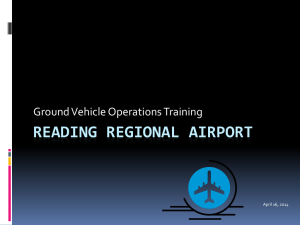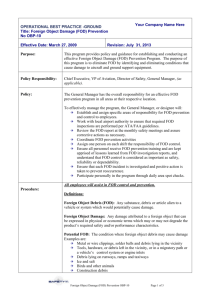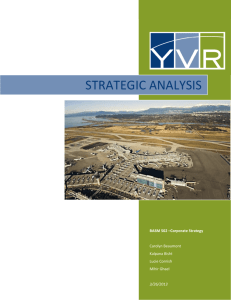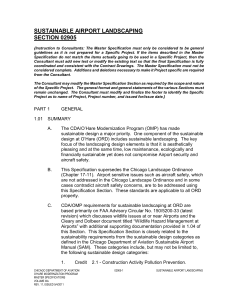Brett Patterson - Director of Airside Operations
advertisement
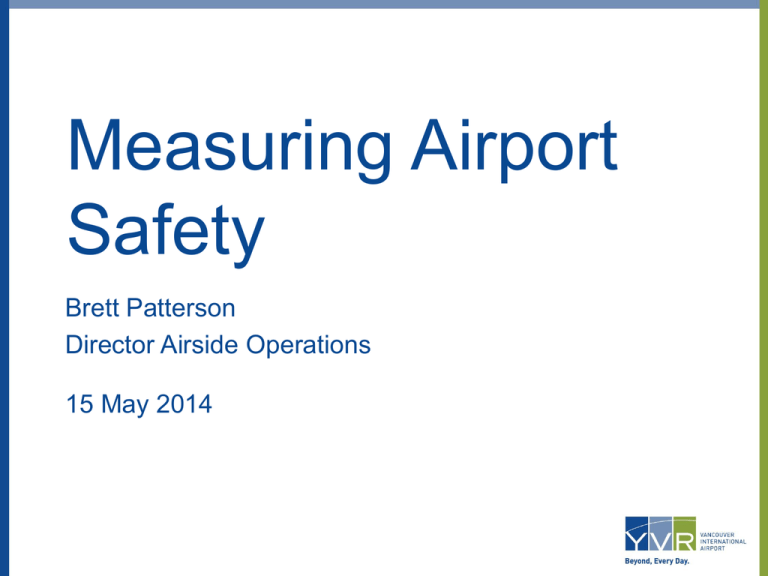
Measuring Airport Safety Brett Patterson Director Airside Operations 15 May 2014 Presentation Outline • The Airport Operator’s Challenges • Safety Performance Measures • Benchmarking • Summary The Airport Operator’s Challenges The Airport AIRPORT OPERATOR AIRLINES Garbage Haulers Contractors Baggage Container Providers Aircraft Washers ANSP Police Ground Handlers Flight Kitchens/Catering Aircraft Fuelers Suppliers GSE Fuelers Ambulance AIRCRAFT MAINTENANCE Airside Security Escorts Structural Fire Fighters In-flight Entertainment Cargo Handlers Regulator Challenges • Data Sharing/Disclosure – Multiple Organizations, known and unknown – Confidentiality • Data quality – Timely – Accurate – Comprehensive • Training All Organizations and Workers Safety Performance Measures Source: ACI Recommended Practice: Airport Safety Performance Measurement – The Use of Safety Key Performance Indicators [Draft March/2014] Safety Measures • Principles • Key Indicators: – Runway – Maneuvering Area – Aprons – Wildlife Management – Safety Management Systems • Safety Culture Principles of Performance Measures • • • • Influenced by airport size/complexity Lagging, Leading and Linked Accessible and Verifiable Data Aid to management – Development of proactive safety controls – Early warning Key Indicators - Runway Lagging • Incursions • Excursions • FOD Incidents • Incidents/ Accidents Leading • Inspections • FOD Retrieved • Program Audits/ Assessments • Runway Safety Team Key Indicators - Runway Leading • Surface Friction Tests and Maintenance • ARFF Response Tests • Runway Safety Training Key Indicators – Maneuvering Area Lagging • Taxiway Incursions • Taxiway Excursions • FOD Incidents • Incidents/ Accidents Leading • Inspections • FOD Retrieved • Program Audits/ Assessments • Maneuvering Area Safety Training Key Indicators - Apron Lagging • Ground Damage – Aircraft – Equipment • Injuries • Hazmat Spills • FOD Incidents Leading • Inspections • Program Audits/ Assessments • Apron Safety Training Key Indicators - Wildlife Lagging • Strikes • Average Mass per Strike* • Total Mass Struck* * Not referenced in ACI Handbook Leading • Patrols/ Inspections • Interventions • Monitoring Surveys • Program Audits/ Assessments Key Indicators - SMS Lagging Leading • # of Reports Received • # of Persons Submitting Reports Key Indicators - SMS Leading • On-time Closure of Corrective Action Plans • On-time Hazard Report Response Audits and Assessments • Internal • External • ACI Airport Excellence Program APEX Safety Performance: Culture Safety Culture “… organizational, managerial and human factors … are the prime causes of accidents in high-reliability industries.” [Weick, K., Sutcliffe, K., Obstfeld, D., 1999. Organizing for reliability: processes for collective mindfulness.] Safety Culture Key Indicators: • • • • • • • • Senior management commitment Management visibility Worker Involvement (engagement) Communication Pressure for production Training Housekeeping Job Satisfaction Measuring Safety Culture The “Safety Climate Survey” – best practice – leading indicator Key Attributes – Periodic – Repeatable – Assess attitudes and perceptions Benchmarking Notes on Benchmarking • No two airports have identical risk profiles • A means to: – identify potential safety issues – assess progress on initiatives • Benchmarking ≠ Marketing • ACI leading development of a database Summary • Yes, airport safety performance can be measured and Airport Operators are taking a leadership role in doing so. • Measuring airport safety performance requires the collaboration, cooperation and engagement of all airport service providers [including regulators]. Brett Patterson Director Airside Operations DIRECT EMAIL 604.276.6141 brett_patterson@yvr.ca WEBSITE yvr.ca FACEBOOK Vancouver International Airport TWITTER BLOG @yvrairport yvr.ca/blog












